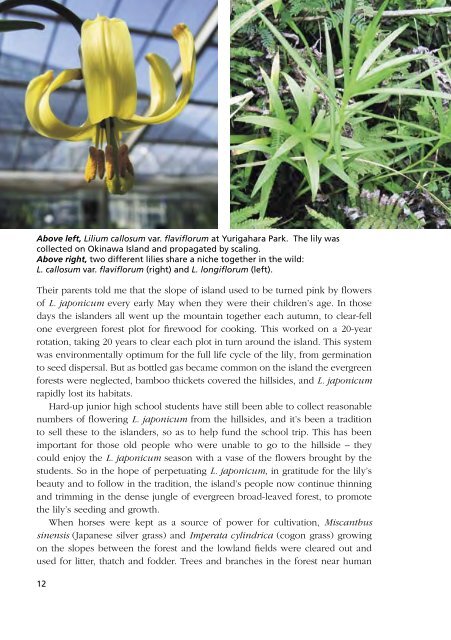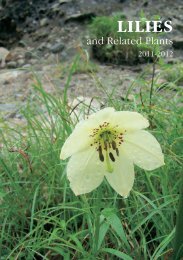LILIES - RHS Lily Group
LILIES - RHS Lily Group
LILIES - RHS Lily Group
Create successful ePaper yourself
Turn your PDF publications into a flip-book with our unique Google optimized e-Paper software.
Above left, Lilium callosum var. flaviflorum at Yurigahara Park. The lily was<br />
collected on Okinawa Island and propagated by scaling.<br />
Above right, two different lilies share a niche together in the wild:<br />
L. callosum var. flaviflorum (right) and L. longiflorum (left).<br />
Their parents told me that the slope of island used to be turned pink by flowers<br />
of L. japonicum every early May when they were their children’s age. In those<br />
days the islanders all went up the mountain together each autumn, to clear-fell<br />
one evergreen forest plot for firewood for cooking. This worked on a 20-year<br />
rotation, taking 20 years to clear each plot in turn around the island. This system<br />
was environmentally optimum for the full life cycle of the lily, from germination<br />
to seed dispersal. But as bottled gas became common on the island the evergreen<br />
forests were neglected, bamboo thickets covered the hillsides, and L. japonicum<br />
rapidly lost its habitats.<br />
Hard-up junior high school students have still been able to collect reasonable<br />
numbers of flowering L. japonicum from the hillsides, and it’s been a tradition<br />
to sell these to the islanders, so as to help fund the school trip. This has been<br />
important for those old people who were unable to go to the hillside – they<br />
could enjoy the L. japonicum season with a vase of the flowers brought by the<br />
students. So in the hope of perpetuating L. japonicum, in gratitude for the lily’s<br />
beauty and to follow in the tradition, the island’s people now continue thinning<br />
and trimming in the dense jungle of evergreen broad-leaved forest, to promote<br />
the lily’s seeding and growth.<br />
When horses were kept as a source of power for cultivation, Miscanthus<br />
sinensis (Japanese silver grass) and Imperata cylindrica (cogon grass) growing<br />
on the slopes between the forest and the lowland fields were cleared out and<br />
used for litter, thatch and fodder. Trees and branches in the forest near human<br />
12




